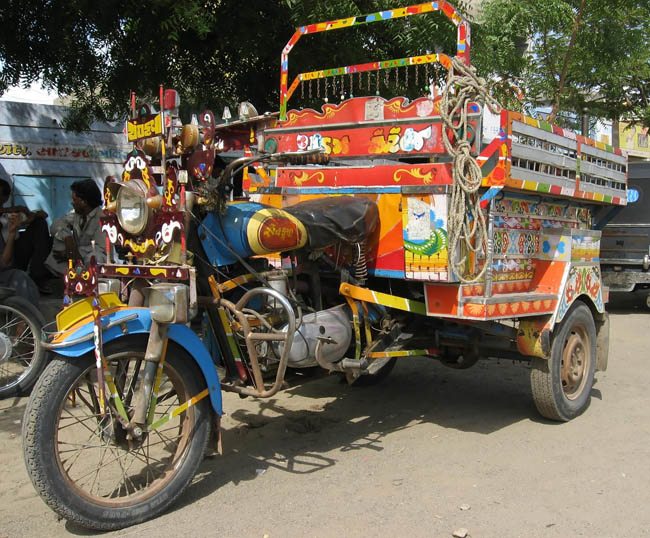Definition of a Motorcycle
The definition of a motorcycle for the Federal Highway Administration’s “Guide to Reporting Highway Statistics” was recently revised and expanded.
There are actually two definitions of a motorcycle.
First is the NHTSA definition in FMVSS 49 CFR 571.3 and then the definition in the reporting guidelines.
The new reporting definition is designed to make the FARS accident reporting statistics more accurate.
Some motorcyclists may not realize that there is an official definition of a motorcycle. Or two, depending upon how you count them!
Recently, the definition was revised for purposes of reporting accident data and I thought the webBikeWorld readers might be interested in a summary.
The new definition was made official on July 27, 2011.
There were several reasons why the changes were made — including requests by motorcyclists and motorcycle-related groups.
Background
Now why, you might ask, is the U.S. government involved in defining a motorcycle?
Well, there are many reasons, not the least of which is to ensure that a standard definition is used by the States when they report accident data.
Standards are good, as has been mentioned many times in the past in various webBikeWorld articles.
Standard definitions, quality standards, manufacturing standards, measurement standards and many more are necessary for modern life.
In this case, something as simple as the definition of a motorcycle is needed because, believe it or not, some of the U.S. states had different definitions for describing a motorcycle.
So when accident data was reported to the FHWA (Federal Highway Administration) for entry in the national statistical database, it was not always comparable.
This information is stored in the Fatality Analysis Reporting System (FARS) of the National Highway Traffic Safety Administration (NHTSA), which is then made available online for public analysis.
Thus, as the FHWA states, “It is critical that the motorcycle registration data collected and published by FHWA is accurate, comprehensive, and timely”.
The Guide to Reporting Highway Statistics
In the last 10 years, new types of two- and three-wheeled vehicles have been developed that are now on the road that weren’t available back when the basic definition of a motorcycle was first created.
Over time, not all of the states were using the same definitions, so some important data was going unreported.
For example, states had different definitions of a motorcycle, scooter or moped (or motorized bicycle) using characteristics as varied as top speed capabilities, engine displacement, horsepower, wheel size, enclosures and other features.
Now you may recall that it was reported in 2010 and 2009 that motorcycle rider fatalities decreased for the first time after 11 consecutive years of increases. But the number of fatalities being reported from 1997 (2,116) to 2008 (5,312) was not proportional to the recorded motorcycle ownership rates.
This caused a bit of a stir in the motorcycle community.
At the 2007 Motorcycle Travel Symposium, sponsored by the NHTSA and FHWA, and attended by various public and private sector motorcycle safety organizations, it was decided that “Guidelines” should be developed to “to gather accurate motorcycle registrations and motorcycle vehicle miles traveled data”.
This includes methods used to collect registration data and vehicle miles traveled.
The motorcycle safety experts in the private and public sectors came to the conclusion that better data reporting was needed to help study motorcycle safety issues.
Some of the reasoning is described in the official Federal Register Notice entitled “Reclassification of Motorcycles (Two and Three Wheeled Vehicles) in the Guide to Reporting Highway Statistics“, which was published on April 28, 2011 and which also represents the final rule, effective July 27, 2011..
From this concern came a decision to start by revising the standard definition of a motorcycle, which would help provide better data to the FARS.
The purpose was to “refine its definition of motorcycles and related two- and three-wheeled vehicles to better differentiate motorcycles, mopeds and motor scooters”.
This was more than just the simple definition; it included guidelines for the states to use to “gather accurate motorcycle registrations and motorcycle vehicle miles traveled data”.
All of this information is included in the Federal Register Notice mentioned above (“Reclassification of Motorcycles (Two and Three Wheeled Vehicles) in the Guide to Reporting Highway Statistics“) published on April 28, 2011 and made final 90 days later, July 27, 2011.
NHTSA Definition of a Motorcycle
The definition of a motorcycle in the National Highway Traffic Safety Administration (NHTSA) Federal Motor Vehicle Safety Standards (FMVSS) spans two categories.
(Note: See 49 CFR 571.3 for the definitions; see 49 CFR 571 main page for the index, including the FMVSS 218 motorcycle helmet “DOT” standards).
The definition is very simple and straightforward, with:
- “Motorcycles” (“two-wheeled and three-wheeled…Sidecars are not regarded as separate vehicles — a motorcycle and sidecar are reported as a single unit”) and
- “Motor Bicycles and Scooters” (including mopeds in the States that require their registration).
The definition is:
“Motorcycle means a motor vehicle with motive power having a seat or saddle for the use of the rider and designed to travel on not more than three wheels in contact with the ground. Motor-driven cycle means a motorcycle with a motor that produces 5-brake horsepower or less.”
FHWA Expanded Definition of a Motorcycle
The expanded definition that was developed for the Guidelines for FARS reporting purposes (and coordinated with NHTSA) now provides more detail and covers more types of two- and three-wheeled vehicles.
These include “Motorcycles With Enclosures” and something called “Personalized Conveyances Licensed for Highway Use”.
This will hopefully increase the accuracy of the reporting from the States. However, the downside is that previous data may not be directly comparable with the new definitions and it is my understanding that no attempt will be made to normalize the data.
Motorcycles:
- Two or three wheels in contact with the ground (excluding trailers suitable for motorcycle hauling).
- A seat or saddle for driver and passengers.
- Wheel rim diameters 10 inches or more.
- Do not include an enclosure for the driver or passengers.
- Sidecars and trailers are not regarded as separate vehicles — a motorcycle and sidecar or trailer is reported as a single unit.
Motorcycles With Enclosures:
- Two or three wheels in contact with the ground (excluding trailers suitable for motorcycle hauling).
- A seat or saddle (in-line or side-by-side) for driver and passengers.
- Wheel rim diameters 10 inches.
- Includes an enclosure for the driver or passengers
- Sidecars and trailers are not regarded as separate vehicles — a motorcycle and sidecar or trailer is reported as a single unit.
Mopeds or Motor Bicycles:
- Two wheels in contact with the ground.
- A seat or saddle for driver and passengers (if any).
- A steering handle bar.
- Do not include an enclosure for the driver or passengers.
- Have a brake horsepower not exceeding 2 HP.
Personalized Conveyances Licensed for Highway Use:
- Two wheels in contact with the ground.
- Has a platform or deck for the use of a standing operator.
- A steering handle bar.
- Do not include an enclosure for the driver or passengers.
- Have a brake horsepower not exceeding 2 HP.
- Have a direct drive energy transmission from the engine to the drive wheel(s) (no transmission).



Other Definitions of a Motorcycle
The American National Standards Institute (ANSI) defines a motorcycle as “any motor vehicle having a seat or saddle for the use of its operator and designed to travel on not more than three wheels in contact with the ground”.
The definition includes “large motorcycles, motor-driven cycles, speed limited motor-driven cycles, mopeds, motor scooters, and motorized or motor assisted bicycles”.
Note that there were 96 comments received after the first announcement, posted on March 23, 2010 and closed on June 24, 2010.
Some of the commenters (including states, motorcycle clubs, organizations and others) wanted the “handle bar” as part of the definition, while others did not.
The final notice is a bit confusing because it indicates that the “handle bar” requirement in the definition would be dropped, but it apparently was not.



Conclusion
A bit of esoterica, for sure, and nothing to lose sleep over, but now you know!
Hopefully this will help improve the accuracy of the FARS accident reporting system.
A careful study of this data is the key to understanding the causes of motorcycle accidents and hopefully in making the streets a safer place for motorcycle riders.
Master Listing of All wBW Motorcycle Product Reviews
Owner Comments and Feedback
See details on submitting comments.
From “M.R.” (August 2011): “How are Quad cycles defined? Saddle, Check. Handle Bar, Check…doesn’t meet the definition,….is it a car?
Many of these aren’t for road use, that’s sure, however how does the reporting of accidents on Quads get captured? I think this is important enough not to leave out…any ideas?”
Editor’s Reply: Good question! If it has four wheels, it’s not a motorcycle. ATVs are not designed to be used on public roads, so they are out of the scope of the NHTSA/FHWA definition.
I believe ATV accidents are tracked as accidents and data is compiled by the Consumer Products Safety Commission. There’s a complete separate website just for ATV information calledATVSafety.gov.
That website has a list of ATV-related fatalities and injuries reported from 1985 to 2009 (2009 is the most recent year for which data is available). In 2009, there were 376 fatalities and 131,900 injuries related to ATV use.
While these are enormous numbers, they are down from the peak year of 2006 with 833 reported fatalities and 2007, with 150,900 injuries reported.



